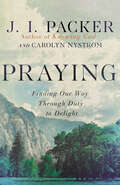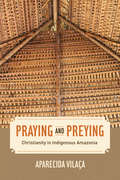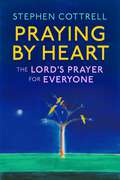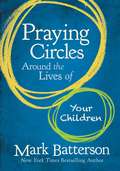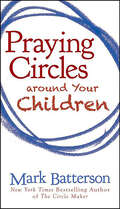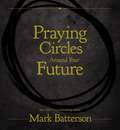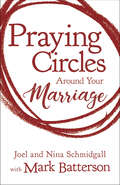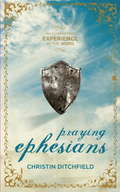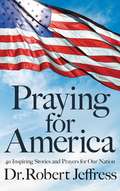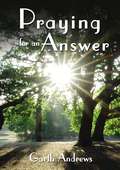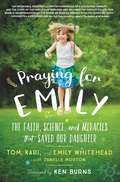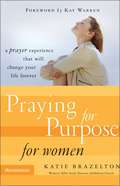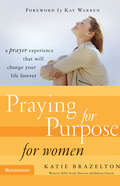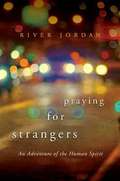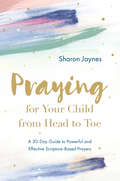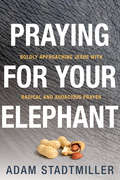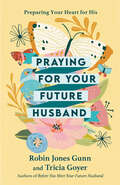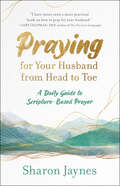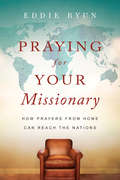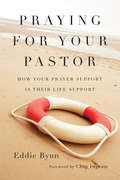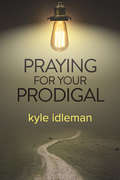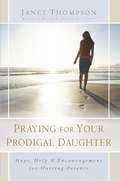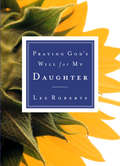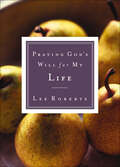- Table View
- List View
Praying: Finding Our Way Through Duty to Delight
by J. I. Packer Carolyn NystromMerit Award, World Guild Christian Living Book Praying is an action that is of the essence of Christian existence. It involves our beliefs, emotions, values, hopes and fears, certainties and uncertainties, knowledge and ignorance. As J. I. Packer and Carolyn Nystrom explain, "Our aim is not just to clarify Christian understanding but to foster Christian living. In real praying, head, heart, and hands go together." With wisdom, humility, and sincerity the authors lead us through different moods of praying, including brooding, praising, asking, complaining, and hanging on. In Praying the authors offer hope for those of us who daydream when we try to listen to God and stumble when we try to speak. Yet they don't just teach us about prayer; they challenge and inspire us to do it by pointing us to a clearer realization of the reality of God and his character. Let Packer and Nystrom guide your praying to our powerful God, and let him move your praying through mere duty to delight.
Praying and Preying
by Aparecida VilaçaPraying and Preying offers one of the rare anthropological monographs on the Christian experience of contemporary Amazonian indigenous peoples, based on an ethnographic study of the relationship between the Wari', inhabitants of Brazilian Amazonia, and the Evangelical missionaries of the New Tribes Mission. Vilaça turns to a vast range of historical, ethnographic and mythological material related to both the Wari' and missionaries perspectives and the author's own ethnographic field notes from her more than 30-year involvement with the Wari' community. Developing a close dialogue between the Melanesian literature, which informs much of the recent work in the Anthropology of Christianity, and the concepts and theories deriving from Amazonian ethnology, in particular the notions of openness to the other, unstable dualism, and perspectivism, the author provides a fine-grained analysis of the equivocations and paradoxes that underlie the translation processes performed by the different agents involved and their implications for the transformation of the native notion of personhood.
Praying by Heart: The Lord's Prayer for Everyone
by Stephen CottrellArchbishop of York Stephen Cottrell argues that the first two words of Christianity's most famous prayer - the Lord's Prayer - encapsulate the radical heart of the Christian faith: that we belong to each other, and that we all have access to God. And if we could understand both these ideas they would truly change our lives - and the world.Unpacking each clause of this ancient prayer both for those who want to encounter it afresh and those beyond church circles, this is the Lord's Prayer recast as a manifesto for the 21st-century church and all who are searching to belong.
Praying by Heart: The Lord's Prayer for Everyone
by Stephen CottrellArchbishop of York Stephen Cottrell argues that the first two words of Christianity's most famous prayer - the Lord's Prayer - encapsulate the radical heart of the Christian faith: that we belong to each other, and that we all have access to God. And if we could understand both these ideas they would truly change our lives - and the world.Unpacking each clause of this ancient prayer both for those who want to encounter it afresh and those beyond church circles, this is the Lord's Prayer recast as a manifesto for the 21st-century church and all who are searching to belong.
Praying Circles Around the Lives of Your Children
by Mark BattersonMark Batterson has a surprising secret weapon to parenting: prayer. Batterson shares a perfect blend of biblical yet practical advice that will revolutionize parents&’ prayer lives by giving them a guide describing seven important ways to pray for their children, such as praying for a hedge of protection and forming prayer circles.Using stories and experience, Batterson shares seven prayer circles that will help parents pray for their kids. In this book parents will learn how to:Create prayer lists unique to the their familyClaim God-inspired promises for their childrenTurn their family circle into a prayer circleDiscover their child's life themesAs Batterson says, &“I realize that not everyone inherited a prayer legacy like I did, but you can leave a legacy for generations to come. Your prayers have the power to shape the destiny of your children and your children's children. It's time to start circling.&”This new version contains 15,000 words of brand-new content.
Praying Circles around Your Children
by Mark BattersonEvery blessing, every breakthrough, and every miracle can be traced back to the prayers that were prayed by you or for you. Join Mark Batterson, New York Times bestselling author of The Circle Maker, as he equips you to become an extraordinary influence in the lives of your children through one simple practice: praying for them.Praying Circles around Your Children combines timeless scriptures with stories of parents just like you, which will revolutionize your prayer life and give you a new perspective on the power of prayer.Along the way, Batterson shares five biblically backed prayer circles that will not only help you pray for your kids, but also pray through your kids.In Praying Circles around Your Children, Batterson will give you the tools you need to:Create prayer lists that are unique to your familyTurn your family circle into a prayer circleClaim God-inspired promises for your childrenThroughout Praying Circles around Your Children, Batterson teaches us that our prayers for our children are the greatest legacy we can leave them. They even have power to shape your family's destiny for generations to come. It's time to start circling.
Praying Circles Around Your Future
by Mark BattersonWhat impossibly big dream has God given you?From Mark Batterson, New York Times bestselling author of The Circle Maker, comes Praying Circles Around Your Future, a beautiful and inspiring book that encourages you to dream big, pray hard,anduncover your heart's deepest desires. With quotes from The Circle Maker Student Edition alongside gorgeous, full-color photographs, you’ll find ways to embrace your God-given dreams and learn to come boldly before God in prayer.Calling on the legend of Honi the Circle Maker—a first century BC Israeli man bold enough to draw a circle in the sand and not budge from it until God answered his prayer—Mark Batterson challenges you to make a prayer circle around your seemingly impossible dreams. God delights in hearing your biggest, boldest prayers, and you’ll feel inspired to see how God will show up in your life.
Praying Circles Around Your Marriage
by Joel Schmidgall Nina Schmidgall Mark BattersonWhat your marriage will become is determined by how you pray. This book empowers you to dream big, pray hard, and think long--together.Marriage is your most sacred relationship on this earth, and prayer is the single most powerful way to transform it. It's time to learn the relational truths in the legend of Honi the Circle Maker--a man bold enough to draw a circle in the sand and not leave it until God answered his impossible prayer. The commitment made in the sacred circle of marriage requires the same kind of boldness and resolve as the Circle Maker. Honi's prayer saved a generation, and your prayers can transform your relationship.Praying Circles around Your Marriage draws from the life-changing principles Mark Batterson outlines in his New York Times bestseller The Circle Maker. Joined by Pastor Joel and Nina Schmidgall who serve with Mark at National Community Church, the authors draw from personal stories, Scripture, and practical insight. You'll discover seven key prayer circles for your marriage: Vision Circle, Romance Circle, War Circle, Dance Circle, Support Circle, Storm Circle, and Legacy Circle. Through these circles you will:Discover your shared vision and find a new combined purpose togetherTurn the tables on conflict and access the gift of being knownBe a student of your spouse and ensure a connected and intimate relationshipBuild a foundation for your marriage that will help you weather the trials that are sure to comeLearn to draw a larger circle around your marriage so that your unified purpose can be a blessing to othersBold prayers honor God, and God honors bold prayers. Praying Circles around Your Marriage will empower you and your spouse to identify your greatest dreams for the most important relationship in your life, and pray the kind of audacious prayers in which God finds delight.After all, your life together has a legacy to leave for future generations. It's time to start circling.
Praying Ephesians: Live Strong! You've Been Chosen For Greatness
by Christin DitchfieldA wonderfully packaged, provocative, and prayer-filled Bible study that immerses readers in a devotional walk through the book of Ephesians, leaving readers both informed and reconnected with God.Ephesians is one of the most cherished books in the New Testament, speaking to such heartfelt concerns as finding God's purpose for your life, being unashamed in your faith, building unity within a fractured church, and battling spiritual warfare. Praying Ephesians takes readers on a journey to uncover the insightful truths of this Pauline epistle by way of guided intimate prayers, important historical backgrounds, word studies, and lots of application and inspirational content. This in-depth study enables readers to connect with God through a rich, prayerful look at His Word.
Praying for America: 40 Inspiring Stories and Prayers for Our Nation
by Dr. Robert JeffressDiscover how to pray powerful prayers for God to bless and unite America in this inspiring guide from the Senior Pastor of First Baptist Church. The most patriotic thing you can do for America is pray for America. In times of division and disaster, our country has a long history of turning to God. Robert Jeffress, the senior pastor of a 14,000-member church in Dallas, Texas, and a Fox News contributor, believes it should be no different today. "When we seek God's help and pray about the issues that affect our lives," writes Jeffress, "we influence the fate of our families, our churches, and our nation. It has happened before in history, and it can happen again." Each chapter of this uplifting book includes an inspiring story demonstrating the power of faith in the life of our nation, a prayer, and a relevant passage of Scripture to inspire and encourage you in praying intently for our country. In these increasingly divided times, Praying for America will serve as a very necessary and timely reminder that "In God, we trust."
Praying For An Answer
by Garth AndrewsJesus encourages persistent prayer (Luke 11, 18). James advocates fervent prayer (James 5). Paul of course both models and instructs ceaseless relentless prayer (Ephesians 6:18, 1Thesalonian 5:17). Prayer is important both for life on earth as well as afterwards (Revelation 5:8 & 8:3-4). Unanswered prayer, though, really focuses the mind, considerably more so than answered prayer.Praying For An Answer is neither a book on prayer nor a manual for praying. Its real objective is to encourage people troubled by the lack of answers to their prayers to consider some kind of scriptural diagnostics to ascertain the cause. It seeks to make the case that no prayer goes unanswered and provides some Biblical conditions that might be used in the diagnostics. It considers &“men of like passion as we are&”, ordinary people &“who prayed earnestly&” unto the living God, which made heaven, and earth, and the sea, and all things that are therein (Acts 14:15 & James 517); and had their prayers answered.Some of the conditions, identified by scripture as significant for answered prayer involve our approach to God, our attitude during the prayer, the integrity of our relationships, our response to scripture and of course how we behave subsequently.Although belief is foundational and fundamental in prayer all too often it is either ignored or discarded resulting in our prayer not even leaving the starting block let alone being answered. For some people it is preferable to allow the answer to be a casualty of their failure to forgive rather than savoring the sweet success of God&’s loving response. This further reduces, rather than increases, the likelihood of their prayer either being heard or answered. It takes so much more than a pretty pious posture to achieve even a modicum of success of an answer to our prayer.The book encourages patience; to wait for the answer rather than prematurely declaring a prayer unanswered. All too often when we are praying we fail to realize that the conditions may have changed, the prayer may have already been answered or a change in tactics might be called for by the Holy Spirit; mainly because we fail to listen whether before, during or after the prayer.And finally, &‘when you have done all to stand&’, and all the diagnostics should prove absolutely useless, it is important that we recognize that God is attentively listening to the cries of, and faithfully rewarding, those who diligently seek him. So, simply pray.
Praying for Emily: The Faith, Science, and Miracles that Saved Our Daughter
by Tom Whitehead Kari Whitehead Emily WhiteheadDiscover the incredible true story of Emily Whitehead, the first child to receive CAR-T cell treatment for her leukemia -- and learn how her family's faith journey guided them in the fight for her life.When their five-year-old daughter was diagnosed with leukemia, Tom and Kari Whitehead's world was shattered. They vowed to do whatever it took to help their daughter, and as they made decisions about how to best treat her, Tom found his faith coming to him in "whispers," guiding his decisions and keeping his hope alive, while Kari placed great faith in science and the doctors surrounding her little girl. But as Emily's condition continued to worsen, they both prayed for a miracle.Then, their miracle arrived, in the form of an experimental treatment called CAR-T cell therapy that, against all odds, saved Emily's life. Because of Emily's miraculous recovery, this treatment is now used widely to treat cancer and has gone on to save hundreds of lives and promises to help thousands more. For all the acclaim and attention this important new approach to treating cancer has received, few know the full story of all it took to make this miracle happen.In Praying for Emily, the Whiteheads share their story, recounting the belief, resilience, and support that got them through the most difficult time of their lives.
Praying for Purpose for Women: A Prayer Experience That Will Change Your Life Forever
by Katherine BrazeltonPraying for purpose for women offers a prayer experience unlike any other.
Praying for Purpose for Women ITPE Edition
by Katie BrazeltonThis 60-day prayer experience will guide you to ask God to mentor you in your life's purposes. Included are insights from modern-day role models, examples of biblical characters, specific questions to ask yourself and to seek God's answers and an eye-opening analysis of your life patterns and purposes.
Praying for Strangers
by River JordanWhat if there was something you could do-something simple, yet so powerful-that could positively influence others and change your life in the process? Critically acclaimed author River Jordan discovered that very thing... As 2009 approached, both of River Jordan's sons were about to go off to war-one to Iraq and the other to Afghanistan-and she was planning a family reunion to see them off. All River could do was pray for her sons' safety and hope to maintain her strength, until she unexpectedly came upon the perfect New Year's resolution-one that focused on others instead of herself. She would pray for a complete stranger every single day of the year.In Praying for Strangers, Jordan tells that the discovery that she made along the journey was not simply that her prayers touched the lives of these strangers (in often astounding ways), but that the unexpected connections she made with other people would be a profound experience that would change her life forever.
Praying for Your Child from Head to Toe: A 30-Day Guide to Powerful and Effective Scripture-Based Prayers
by Sharon JaynesPrayer is a parent&’s greatest superpower! This unique devotional for mothers leads you through sixteen areas of your child&’s life from head (thoughts) to shoulders (burdens) to hands (gifts) to feet (the path ahead). God has given parents the privilege of shaping not just a human being but an eternal soul. That responsibility can feel overwhelming, especially when it comes to prayer. How can we truly pray for our kids rather than fall into a spiral of worry? In Praying for Your Child from Head to Toe, bestselling author Sharon Jaynes helps us use the words of Scripture to pray over our children with intention. This practical and encouraging guide offers: A unique head-to-toe pattern to help us make prayer for our kids a natural habit Thirty brief reflections with sixteen prayers each, taking you from prayers for your child&’s mind, eyes, and ears, to their shoulders, gifts, and relationships Flexibility, whether you are looking for a month-long devotional or Scripture prayers to use again and again As Sharon reminds us, prayer is not a means of gaining control over our children to make them the men and women we want them to be. Prayer is a means of relinquishing control and asking God to shape our children into the men and women that He wants them to be. Presented by Esther Press: Books for Courageous Women
Praying for Your Elephant: Boldly Approaching Jesus with Radical and Audacious Prayer
by Adam StadtmillerGet ready to re-ignite, re-imagine, and repurpose your prayer life while experiencing great intimacy with God. This is an invitation to identify your elephants--to name, through specific and strategic prayers, the 100 most important and audacious petitions you can imagine. These are the elephants that--if answered by God--would be game changers in your life and perhaps the world.
Praying for Your Future Husband: Preparing Your Heart for His
by Robin Jones Gunn Tricia GoyerHave you ever thought about praying for your future husband?Will it make a difference?There's only one way to find out... From when we were small girls, most of us dream of "The One," our future husband. We think about what it would be like to be a bride. We wonder who that special guy is and when we'll find him. The great news is that what you do now can make a difference in your life and the life of your future husband! Authors and good friends Robin Jones Gunn (Christy Miller series) and Tricia Goyer (author and former teen mom) believe God answers women's prayers for husbands--even husbands they may not meet for years. They invite young women to pray boldly for their future mate ... while also asking God to prepare their own hearts. In Praying for Your Future Husband, Robin and Tricia share their two vastly different experiences, including the things they did right and the mistakes they made on the path to meeting and marrying their husbands. Each chapter includes helpful Bible verses, prayers, and practical application, along with true stories of women who prayed for a husband and how God answered in remarkable ways. God has a beautiful romance prepared for you. Prayer is the key to unlocking the love story ... with your future husband and with God, the lover of your soul.From the Trade Paperback edition.
Praying for Your Husband from Head to Toe: A Daily Guide to Scripture-Based Prayer
by Sharon JaynesPowerful, effective prayer for your husband is easier than you think.&“I have never seen a more practical book on how to pray for your husband.&”—Gary Chapman, PhD, author of The Five Love Languages As a wife, no one is more called or qualified than you to pray for your husband. Yet sometimes, it&’s hard to find the words. You wonder: What should I pray? How should I pray? What prayers does he need right now?In Praying for Your Husband from Head to Toe, Sharon Jaynes maps out sixteen areas of a man&’s life to help you consistently and effectively cover your husband in prayer. From his mind and the thoughts he thinks, to his eyes and the images he sees, all the way down to his feet and the path he takes, Sharon teaches you how to pray for your husband in ways that are powerful, practical, and life-changing. You&’ll learn how to:• Cover each area of your husband&’s life with specific scriptural prayers, knowing that when you pray the Word of God, you pray the will of God. • Become a prayer warrior who is equipped and empowered for intercession that makes a difference in the physical and spiritual realms.• Stop your mind from wandering during prayer by following a pattern that helps you stay focused and fervent, with faith-filled expectancy.• Establish a habit of purposeful prayer in just a few dedicated minutes each day.Whether you&’re newly married or you and your husband have grown gray together, you&’ll use this prayer guide again and again to bless your marriage and your man.
Praying for Your Missionary: How Prayers from Home Can Reach the Nations
by Eddie ByunBeing a missionary is a noble calling, but it's also a difficult one.
Praying for Your Pastor: How Your Prayer Support Is Their Life Support
by Eddie ByunIt's tough to be a pastor. Pastors face demands and pressures on every side, from the challenges of church ministry to the realities of spiritual warfare. But you can make a difference. Your prayers provide a lifeline for your pastor's spiritual health and ministry effectiveness. Eddie Byun offers a handy, practical guide to praying for pastors. He shares stories of how congregational intercession changes things, with specific guidelines for prayers for protection, rest, anointing, integrity and more. God calls us to pray for our leaders. When we do, their ministry is strengthened, the kingdom is advanced and lives and communities are transformed.
Praying for Your Prodigal: Aha, 40 Days To Lasting Change, Praying For Your Prodigal
by Kyle IdlemanA book for parents and family members of those who are far from God, Praying for Your Prodigal draws on insights from AHA to help readers pray--and hope--for their prodigal. In this hope-filled, honest book Kyle Idleman offers stories about prodigals specifically for parents and grandparents of prodigals, as well as a series of prayers for readers to work through as they offer their prodigals to God.
Praying for Your Prodigal Daughter
by Janet ThompsonOffering hope, help, and encouragement to hurting parents of prodigal daughters, author Janet Thompson shares out of her own experience as a prodigal daughter and as the mother of a prodigal daughter. And the key to the help she offers is prayer. While you, as a hurting mom or dad, may know that you need to pray for your daughter, this walk-along-beside-you book will take you gently by the hand and show you how. In it you will find candid stories of other parents of prodigals -- and even the stories of prodigals themselves. Don't wait until you have a prodigal situation. Any parent will benefit from this book's incredible insights, prayers, and stories. Praying for Your Prodigal Daughter is about hope, help, and support from others who have walked a similar road. Chapter Topics Include Setting Boundaries Surviving in Marriage Resolving Conflict Making it All About Her What Did We Do to Cause This?
Praying God's Will for My Daughter
by Lee RobertsWhether you are praying for particular needs--confidence, protection, forgiveness--or for your daughter to experience the power and presence of God, this book contains the perfect prayers. With hundreds of prayers grouped according to specific needs and based entirely on Scripture, you will always have within your reach a rich resource of personal, inspirational prayers.
Praying God's Will for My Life (Praying God's Will Ser.)
by Lee RobertsWhether you are praying for specific needs--confidence, protection, forgiveness--or for you to experience the presence and power of God, you will find the perfect prayers contained in this book. With hundreds of prayers grouped according to topic and based entirely on Scripture, you will have within your reach a rich resource of personal, inspirational prayer.
